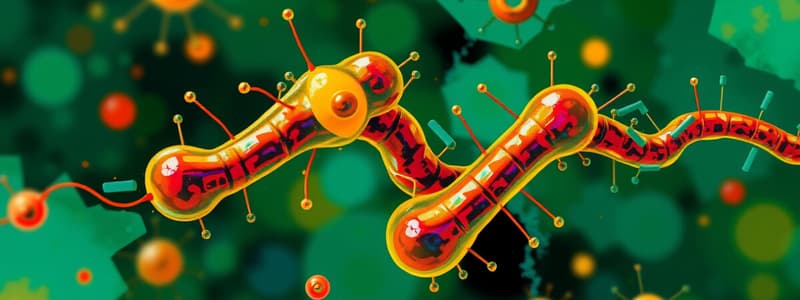Podcast
Questions and Answers
What is the major stimulus of endogenous insulin secretion?
What is the major stimulus of endogenous insulin secretion?
Glucose
The brain relies on glucose transport mediated by insulin.
The brain relies on glucose transport mediated by insulin.
False (B)
What is the primary cause of Type 2 diabetes?
What is the primary cause of Type 2 diabetes?
- Insulin resistance
- Genetic predisposition
- Lack of exercise
- Obesity (correct)
Which type of diabetes requires exogenous insulin for survival?
Which type of diabetes requires exogenous insulin for survival?
What are the symptoms associated with diabetes mellitus?
What are the symptoms associated with diabetes mellitus?
What are sulfonylureas primarily used for?
What are sulfonylureas primarily used for?
Insulin promotes glucose into fat cells, which is broken down to ______.
Insulin promotes glucose into fat cells, which is broken down to ______.
What is the main complication of insulin treatment if too much is administered?
What is the main complication of insulin treatment if too much is administered?
What is metformin used for?
What is metformin used for?
What can DPP-4 inhibitors potentially cause?
What can DPP-4 inhibitors potentially cause?
What do GLP-1 agonists mimic?
What do GLP-1 agonists mimic?
Which insulin type has an onset of 4-8 hours?
Which insulin type has an onset of 4-8 hours?
What is the role of insulin in carbohydrate metabolism?
What is the role of insulin in carbohydrate metabolism?
What effect does hyperglycemia have on organ function in diabetes mellitus?
What effect does hyperglycemia have on organ function in diabetes mellitus?
What is the primary reason for the breakdown of proteins in the absence of adequate insulin?
What is the primary reason for the breakdown of proteins in the absence of adequate insulin?
Which factor notably inhibits insulin secretion?
Which factor notably inhibits insulin secretion?
What is the composition of endogenous insulin?
What is the composition of endogenous insulin?
Which cells are primarily affected by insulin to facilitate glucose utilization?
Which cells are primarily affected by insulin to facilitate glucose utilization?
What metabolic process is promoted by insulin in fat cells?
What metabolic process is promoted by insulin in fat cells?
What test result indicates hyperglycemia in relation to diabetes?
What test result indicates hyperglycemia in relation to diabetes?
What is the primary route of administration for exogenous insulin?
What is the primary route of administration for exogenous insulin?
What is the peak action time for rapid-acting insulin such as Insulin Lispro?
What is the peak action time for rapid-acting insulin such as Insulin Lispro?
Which insulin type is known to be the only one that can be administered intravenously?
Which insulin type is known to be the only one that can be administered intravenously?
What distinguishes insulin analogs from standard insulin?
What distinguishes insulin analogs from standard insulin?
How long does it take for intermediate-acting insulin (NPH) to reach its peak effect?
How long does it take for intermediate-acting insulin (NPH) to reach its peak effect?
What is the duration of action for short-acting insulin?
What is the duration of action for short-acting insulin?
In what situation is insulin used to treat hyperkalemia?
In what situation is insulin used to treat hyperkalemia?
Which insulin type has an onset time of approximately 4-8 hours?
Which insulin type has an onset time of approximately 4-8 hours?
What is a key benefit of using rapid-acting insulins in diabetes management?
What is a key benefit of using rapid-acting insulins in diabetes management?
In which scenario might short-acting insulin be preferred over rapid-acting insulin?
In which scenario might short-acting insulin be preferred over rapid-acting insulin?
What is a characteristic of Type 1 diabetes?
What is a characteristic of Type 1 diabetes?
Which of the following is a marker associated with Type 1 diabetes?
Which of the following is a marker associated with Type 1 diabetes?
What happens to glucose uptake in Type 2 diabetes?
What happens to glucose uptake in Type 2 diabetes?
What best describes the secondary effect of lifestyle changes on diabetes management?
What best describes the secondary effect of lifestyle changes on diabetes management?
What complication arises if patients with Type 2 diabetes do not manage their lifestyle?
What complication arises if patients with Type 2 diabetes do not manage their lifestyle?
At what frequency is HbA1c typically monitored?
At what frequency is HbA1c typically monitored?
Which population is likely to develop Type 2 diabetes?
Which population is likely to develop Type 2 diabetes?
What is the underlying issue in Type 2 diabetes?
What is the underlying issue in Type 2 diabetes?
What percentage of diabetes cases is attributed to Type 1 diabetes?
What percentage of diabetes cases is attributed to Type 1 diabetes?
What is the primary consequence of obesity in relation to Type 2 diabetes?
What is the primary consequence of obesity in relation to Type 2 diabetes?
What is a significant concern when using metformin in patients undergoing imaging with iodine-containing contrast media?
What is a significant concern when using metformin in patients undergoing imaging with iodine-containing contrast media?
Which class of diabetes medication is known for causing gastrointestinal side effects such as bloating and diarrhea?
Which class of diabetes medication is known for causing gastrointestinal side effects such as bloating and diarrhea?
What is a primary mechanism of action for GLP-1 agonists in diabetes management?
What is a primary mechanism of action for GLP-1 agonists in diabetes management?
Which medication class should be contraindicated in patients with liver disease or elevated ALT levels?
Which medication class should be contraindicated in patients with liver disease or elevated ALT levels?
Which statement about DPP-4 inhibitors is true?
Which statement about DPP-4 inhibitors is true?
What is the primary goal of intensive insulin therapy in diabetes management?
What is the primary goal of intensive insulin therapy in diabetes management?
Which of the following insulin combinations is a 70/30 mixture?
Which of the following insulin combinations is a 70/30 mixture?
What characterizes the treatment approach in standard insulin therapy?
What characterizes the treatment approach in standard insulin therapy?
Which complication can arise from excessive insulin administration?
Which complication can arise from excessive insulin administration?
Which medication primarily works by increasing the release of insulin?
Which medication primarily works by increasing the release of insulin?
Who should be cautious about using sulfonylureas?
Who should be cautious about using sulfonylureas?
What is the primary side effect associated with the use of sulfonylureas?
What is the primary side effect associated with the use of sulfonylureas?
What is the impact of intensive insulin therapy compared to standard therapy in managing diabetes?
What is the impact of intensive insulin therapy compared to standard therapy in managing diabetes?
Which of the following is NOT a characteristic of intensive insulin therapy?
Which of the following is NOT a characteristic of intensive insulin therapy?
Which type of diabetes can utilize oral diabetic drugs like sulfonylureas?
Which type of diabetes can utilize oral diabetic drugs like sulfonylureas?
Flashcards are hidden until you start studying
Study Notes
Chronic Systemic Disease
- Characterized by metabolic and vascular abnormalities affecting carbohydrate metabolism.
- Hyperglycemia can lead to organ failure due to vascular changes.
- Glucose is the sole sugar used by the body for energy.
- Insulin is essential for moving glucose into organs, except for the brain, which does not depend on insulin for glucose transport.
Insulin Production and Physiology
- Insulin consists of two polypeptides linked by disulfide bonds, produced by pancreatic beta cells.
- Precursor protein, proinsulin, is cleaved into insulin and C-peptide upon secretion.
- Glucose stimulates insulin secretion, while factors such as hypoxia and stimulation of alpha-adrenergic receptors inhibit it.
- Insulin promotes glucose utilization in liver, muscle, and fat cells essential for energy production.
Metabolism Effects of Insulin
- Fat metabolism: Insulin assists in converting glucose to triglycerides in fat cells, promoting cholesterol and phospholipid increase.
- Protein metabolism: Insulin enhances protein synthesis by facilitating amino acid transport; lack of insulin causes protein breakdown into amino acids.
Diabetes Mellitus (DM)
- Symptoms include weight loss, weakness, hyperglycemia, glucosuria, polyuria, polydipsia, and polyphagia.
- Fasting blood glucose above 126 can indicate diabetes, as well as complications like PVD and cardiovascular diseases.
Type 1 Diabetes Mellitus
- Absolute insulin deficiency; patients require exogenous insulin for survival.
- Often an autoimmune disorder destroying pancreatic beta cells, with sudden onset.
- Comprises around 10% of diabetes cases, characterized by elevated GAD antibodies.
Type 2 Diabetes Mellitus
- Patients produce insufficient insulin and may experience insulin receptor resistance.
- Associated with obesity; presents as gradual onset with less severe symptoms initially.
- 90% of diabetes cases, characterized by insulin resistance leading to hyperglycemia.
- HbA1c levels give insight into long-term glucose control.
Treatment Options for Diabetes Mellitus
- Insulin treatments: classified by onset and duration.
- Exogenous insulin is nearly identical to endogenous, primarily given subcutaneously, except for one type that is IV.
- Types include rapid-acting, short-acting, intermediate-acting, and long-acting insulin with varying onset, peak, and duration times.
Oral Diabetic Medications (Type 2)
- Sulfonylureas: Stimulate insulin release from beta cells; primary side effect is hypoglycemia.
- Alpha-glucosidase inhibitors: Delay carbohydrate absorption; can cause gas and diarrhea.
- Biguanides (Metformin): Increase glucose utilization, decrease hepatic production, and do not cause hypoglycemia; contraindications include renal and liver impairment.
- Glitazones (TZDs): Insulin sensitizers that improve glucose uptake; may cause fluid retention and heart failure issues.
Other Oral Medications
- DPP-4 inhibitors: Enhance insulin secretion while inhibiting glucagon release; potential side effects include gastrointestinal issues and pancreatitis.
- GLP-1 agonists: Increase insulin secretion and satiety, reduce gastric emptying; associated with nausea and potential thyroid tumors.
- SGLT2 inhibitors: Inhibit glucose reabsorption in kidneys, leading to increased urine output and possible dehydration.
Management Paradigms
- Intensive treatment: Aims for normoglycemia with frequent injections leading to reduced long-term complications by 60%.
- Standard treatment: Less frequent injections aiming for higher glucose targets.
Complications of Insulin Therapy
- Excess insulin can cause comas, seizures, hypoglycemia, and other physiological disturbances such as tachycardia and confusion.
Chronic Systemic Disease
- Characterized by metabolic and vascular abnormalities affecting carbohydrate metabolism.
- Hyperglycemia can lead to organ failure due to vascular changes.
- Glucose is the sole sugar used by the body for energy.
- Insulin is essential for moving glucose into organs, except for the brain, which does not depend on insulin for glucose transport.
Insulin Production and Physiology
- Insulin consists of two polypeptides linked by disulfide bonds, produced by pancreatic beta cells.
- Precursor protein, proinsulin, is cleaved into insulin and C-peptide upon secretion.
- Glucose stimulates insulin secretion, while factors such as hypoxia and stimulation of alpha-adrenergic receptors inhibit it.
- Insulin promotes glucose utilization in liver, muscle, and fat cells essential for energy production.
Metabolism Effects of Insulin
- Fat metabolism: Insulin assists in converting glucose to triglycerides in fat cells, promoting cholesterol and phospholipid increase.
- Protein metabolism: Insulin enhances protein synthesis by facilitating amino acid transport; lack of insulin causes protein breakdown into amino acids.
Diabetes Mellitus (DM)
- Symptoms include weight loss, weakness, hyperglycemia, glucosuria, polyuria, polydipsia, and polyphagia.
- Fasting blood glucose above 126 can indicate diabetes, as well as complications like PVD and cardiovascular diseases.
Type 1 Diabetes Mellitus
- Absolute insulin deficiency; patients require exogenous insulin for survival.
- Often an autoimmune disorder destroying pancreatic beta cells, with sudden onset.
- Comprises around 10% of diabetes cases, characterized by elevated GAD antibodies.
Type 2 Diabetes Mellitus
- Patients produce insufficient insulin and may experience insulin receptor resistance.
- Associated with obesity; presents as gradual onset with less severe symptoms initially.
- 90% of diabetes cases, characterized by insulin resistance leading to hyperglycemia.
- HbA1c levels give insight into long-term glucose control.
Treatment Options for Diabetes Mellitus
- Insulin treatments: classified by onset and duration.
- Exogenous insulin is nearly identical to endogenous, primarily given subcutaneously, except for one type that is IV.
- Types include rapid-acting, short-acting, intermediate-acting, and long-acting insulin with varying onset, peak, and duration times.
Oral Diabetic Medications (Type 2)
- Sulfonylureas: Stimulate insulin release from beta cells; primary side effect is hypoglycemia.
- Alpha-glucosidase inhibitors: Delay carbohydrate absorption; can cause gas and diarrhea.
- Biguanides (Metformin): Increase glucose utilization, decrease hepatic production, and do not cause hypoglycemia; contraindications include renal and liver impairment.
- Glitazones (TZDs): Insulin sensitizers that improve glucose uptake; may cause fluid retention and heart failure issues.
Other Oral Medications
- DPP-4 inhibitors: Enhance insulin secretion while inhibiting glucagon release; potential side effects include gastrointestinal issues and pancreatitis.
- GLP-1 agonists: Increase insulin secretion and satiety, reduce gastric emptying; associated with nausea and potential thyroid tumors.
- SGLT2 inhibitors: Inhibit glucose reabsorption in kidneys, leading to increased urine output and possible dehydration.
Management Paradigms
- Intensive treatment: Aims for normoglycemia with frequent injections leading to reduced long-term complications by 60%.
- Standard treatment: Less frequent injections aiming for higher glucose targets.
Complications of Insulin Therapy
- Excess insulin can cause comas, seizures, hypoglycemia, and other physiological disturbances such as tachycardia and confusion.
Studying That Suits You
Use AI to generate personalized quizzes and flashcards to suit your learning preferences.



